FEATURES|THEMES|Environment and Wildlife
Stepping Up to the Plate: An Invitation to Open Your Heart to Nature and Walk the Talk
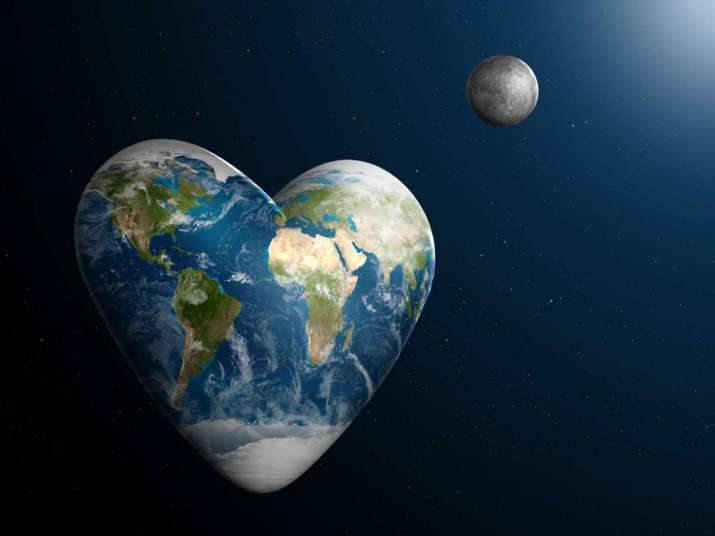 From Pinterest
From PinterestIn 1973, German psychologist Erich Fromm coined the term “biophilia” to describe “the passionate love of life and of all that is alive.” (Fromm 1973, 522) A decade later, American biologist Edward O. Wilson defined biophilia in his book of the same title as “the urge to affiliate with other forms of life.” The idea resonates with the concepts of universal interconnectedness, reverence for life, and metta or loving-kindness, which are at the centre of Buddhist philosophy. I believe that embracing and integrating these ideas into our lives provides the solution to the most serious crisis ever faced by life on Earth, as the frantic scramble for power, identity, and resources that grips our increasingly crowded, consumerist, dog-eat-dog society drowns out our sense of interconnectedness and affinity with each other and the natural world.
The 200,000-year history of human colonization of this world has resulted in the most dramatic planetary takeover since life began. Initially, our limited numbers largely diluted our impact on the planet’s diversity of life. When the Buddha was born in 623 BCE, the Earth was home to approximately 154 million people. We crossed the 1 billion mark sometime in the early 19th century, and in the course of my lifetime alone the population has risen from 3 billion people in 1960 to more than 7.5 billion today. The human population is projected to reach 9.8 billion by 2050 and 11.2 billion by 2100. Humanity’s impact on the Earth is now so profound that experts refer to the current geological epoch as the Anthropocene—the age of man. It is defined by nuclear tests, plastic pollution, mass livestock production, and the degradation of the entire global ecosystem that all organisms, including humans, depend on for air, water, food, and shelter.
As the human population grows, so does our impact on the environment. Humans are now the primary driver of species extinction. We have dialed up the rate at which species are disappearing to around 1,000 times that of natural extinction rates. As if that wasn’t terrifying enough, the speed of species loss is expected to be 10,000 times higher in the future, affecting countless terrestrial, marine, and freshwater species. Large-bodied animals are particularly at risk, either because they are in our way or because we like to eat them or their body parts. Thus, we have set over 60 per cent of all large herbivores, such as rhinos, elephants, giraffes, and hippos, and three quarters of large predators who depend on large herbivores, such as lions, tigers, wolves, and leopards, on a course to oblivion. Their loss will have far-reaching and unexpected downstream effects on other species, the structure of their habitats, and ecological processes. One in four mammal species are threatened with extinction, as are 42 per cent of amphibians, all marine turtles, nearly half of all crocodiles, a third of all cacti and conifers, 60 per cent of turtles and tortoises, and over 30 per cent of reef-forming corals, sharks and rays, and freshwater crabs and crayfish, to name a few. Each species lost means that a unique strand in the web of life and the result of 4 billion years of evolution is gone for good. There are no winners in this global game of ecological Jenga, as each species’ loss brings all of us one step closer to global ecosystem collapse. “The services and economic value that species provide are irreplaceable and essential to our well-being. Unless we live within the limits set by nature, and manage our natural resources sustainably, more and more species will be driven towards extinction. If we ignore our responsibility we will compromise our own survival,” said Dr. Jane Smart, director of the IUCN Global Species Programme.*
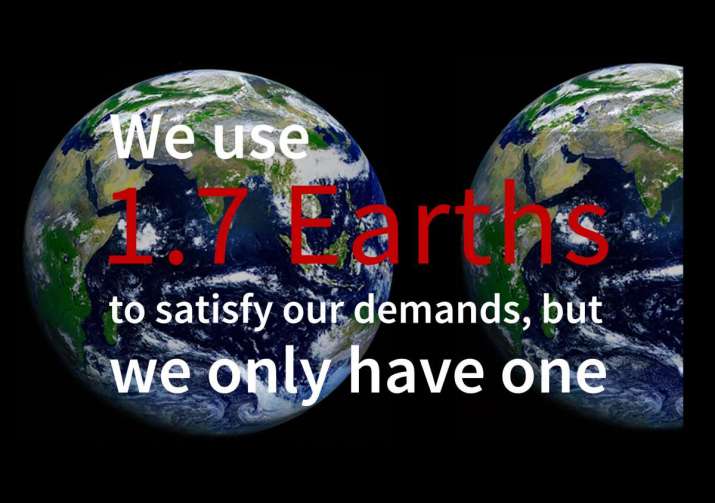
So, what’s going on? The short answer is that the sheer onslaught of human population growth and associated consumption has simply outstripped the planet’s biocapacity. The Earth’s ecosystems are like a bank account; if what you take out exceeds what goes back in, you’re heading for bankruptcy. Earth Overshoot Day (EOD) marks the annual date when humanity has used more from nature than nature can regenerate that year. Since it was first calculated in 1971, this date has crept steadily backwards by nearly five months, indicating that the entire planet is in a deepening ecological deficit. This year, EOD falls on 2 August.
Three quarters of the world’s threatened species are imperiled because people are converting their habitats into agricultural lands and overharvesting their populations. When Sean Maxwell and colleagues analyzed the threats to all 8,688 species currently on the IUCN Red List of Threatened Species, they found that whatever the threat category or species group, overexploitation and agriculture had by far the greatest impact.
Overexploitation refers to the removal of individual plants and animals from the wild at rates that cannot be compensated for by reproduction or regrowth. Whether for commerce, recreation, or subsistence, overexploitation imperils 72 per cent of species. Rhinos, gorillas, sharks, pangolins, bears, tigers, and elephants are just a few of the more than 2,700 species affected by illegal hunting as a result of market demand for their body parts and meat, or by people plucking them from the wild to be sold as exotic pets.
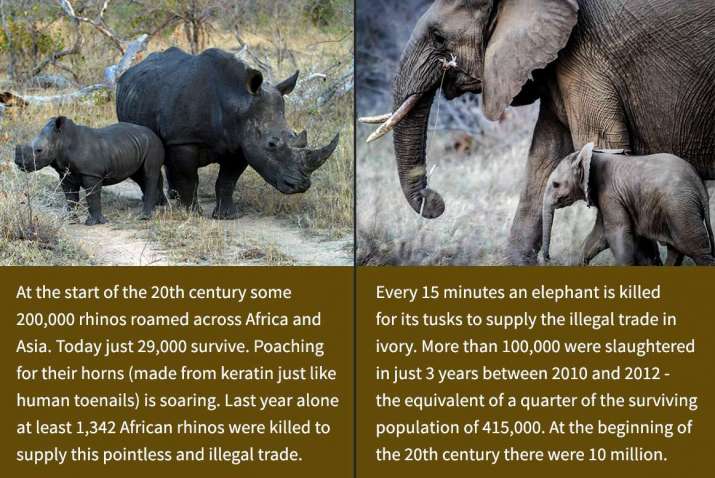
Some endangered species can only be found inside protected areas, such as national parks, and even there they are not even safe. The surge in wildlife trade in recent years is industrial in scale and largely due to a rise in demand in Asia. According to Interpol, wildlife trafficking is worth US$7–23 billion per year and, together with arms, narcotics, and human trafficking, now ranks among the four most lucrative illicit trade commodities. It is driven by transnational organized crime syndicates that target high-value wildlife without regard for the lives of the animals or people affected. They corrupt local officials, recruit and arm local poachers, create insecurity, and put local communities into a poverty spiral. Every 15 minutes an elephant is killed for its tusks. Poaching and the illegal trade in ivory have long been the main threats to these majestic animals. In 2010–12, more than 100,000 African elephants were slaughtered—the equivalent of 25 per cent of the surviving population of 415,000. At the beginning of the 20th century there were 10 million. Poaching rhinos for their horns (made from keratin, the same material as human toenails) has also soared in recent years. While its use in traditional Asian medicine persists, rhino horn is increasingly used for display as status symbols, “party drugs” to relieve hangovers, and for jewelry and other trinkets, or in the tragically mistaken belief that it can enhance male sexual potency. As a result, rhino populations are under siege. Last year, at least 1,342 African rhinos were killed, the highest number since records began. The full horror of the situation becomes clear when we consider that a single 3 gram dose of rhino horn administered to 3.9 per cent of adults in China and Vietnam would require the horns of every last rhino on the planet.
Agricultural activities, including the production of food, fodder, fiber, and fuel crops, as well as livestock farming, aquaculture, and the cultivation of trees, threaten 62 per cent of species. A staggering 80 per cent of all threatened terrestrial bird and mammal species are being pushed toward extinction by agriculturally driven habitat loss. The World Food and Agriculture Organization (FAO) estimates that global livestock production accounts for 14.5 per cent of the world’s greenhouse gas emissions, while the World Watch Institute believes the figure could be as high as 51 per cent. Either way, meat and dairy production are the primary contributors of greenhouse gas emissions. Even at lower estimates, livestock production emissions exceed that of the entire transportation sector, which includes cars, trucks, trains, ships, and aircraft. And it’s going to get great deal worse because our per capita consumption of meat and dairy products continues to rise. According to the FAO, the human population is predicted to increase by 33 per cent by 2050, while demand for meat and livestock products is expected to shoot up by 73 per cent as a result of growing affluence and urbanization.
We live in a world where the collective mass of the world’s livestock animals already exceeds that of wild land mammals by at least 10 times. This upsurge in livestock continues to reduce the availability of grazing and water for wild animals, raises the risk of disease transmission from domestic to wild species, and increases human-wildlife conflict, particularly in the developing world, where livestock production tripled between 1980 and 2002.
The extent of these threats is largely determined by the growth in human populations and per capita income, which drives rising demand for agricultural land and animal protein. It simply cannot go on like this.
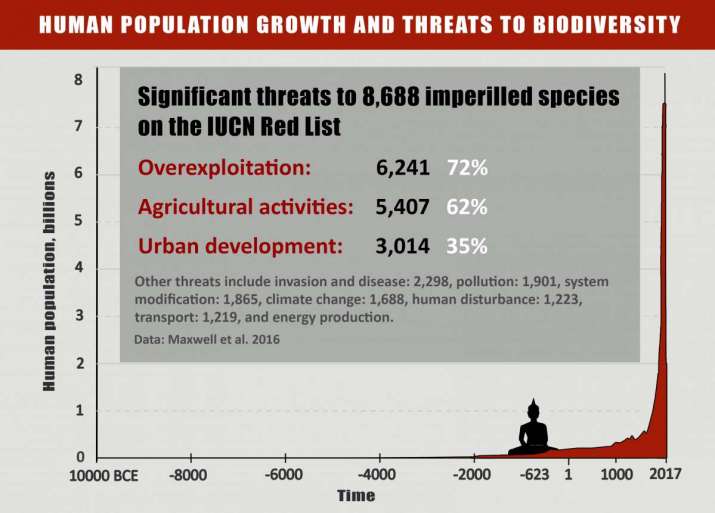
It takes 14 times as much land to produce a tonne of beef than to produce the equivalent amount of grain. Moving toward a plant-based diet would therefore slow climate change and confer significant biodiversity conservation benefits. Recognizing the far-reaching climatic and environmental impacts of meat consumption, China last year announced plans to cut the country’s meat consumption by 50 per cent. A study by Oxford University researcher Marco Springmann and colleagues in 2016** has shown that adopting a vegetarian or vegan diet would cut food-related emissions by 63 per cent and 70 per cent, respectively. Put bluntly, without making these changes, we will be unable to keep global warming below the dangerous level of 2ºC, which was agreed by 196 nations in the 2015 Paris climate accord.
Meat-free eating also provides significant health benefits, including lower blood pressure and cholesterol, as well as a reduced risk of chronic illnesses such as heart disease, colon cancer, and type 2 diabetes. Springmann and colleagues estimate that a plant-based diet could save up to 8 million lives by 2050, lead to healthcare-related savings and could avoid climate-related damages totaling US$1.5 trillion. Perhaps surprisingly, three-quarters of these benefits would occur in developing countries. The researchers estimate the overall economic benefits to be US$1–31 trillion—equivalent to 0.4–13 per cent of projected global GDP in 2050.
It is up to us to be the light at the end of this tunnel, but will we be able to use compassion and wisdom to make the changes that are clearly necessary? For many, compassion alone is reason enough to steer clear of meat and animal products. For many more kindness and common sense stop when it comes to what’s on their plate. I grew up in Germany on a traditional German diet dominated by meat and sausages. I also witnessed first-hand the desperate suffering to which we subject domestic animals from the moment they are born to their violent deaths and gave up meat some 30 years ago because I could no longer reconcile my behavior with my conscience. Looking back, this was one of the best decisions I ever made. My only regret is that I waited so long. I am sharing this with you in the hope that it will strengthen your resolve and your belief that you, too, can take this important step towards a natural, healthy and compassionate diet—whether out of kindness toward individual animals or humans, or our planet’s life support system as a whole.
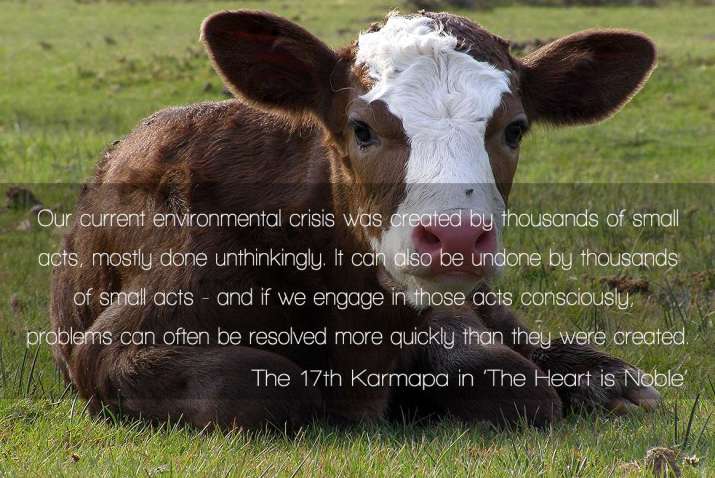
In the words of Vietnamese Zen master Thich Nhat Hanh, “We must look deeply. When we buy something or consume something, we may be participating in an act of killing. This precept [non-killing] reflects our determination not to kill, either directly or indirectly, and also to prevent others from killing.” Recognizing that we are at a crucial crossroads, where our survival and that of other species is at stake as a result of human actions, the Buddhist Climate Change Statement urges reduced consumption and the adoption of a plant-based diet. Earlier this year, Buddhist leaders, leading scientists, and scholars met in India to develop practical action plans to address, among other issues, the current environmental crisis. The resulting Nalanda Declaration on Animals and the Environment acknowledges the responsibility of the Buddhist community in preventing further species loss and animal suffering through the consumption of wildlife products and meat. In fact, the Buddha himself encourages us to integrate respect and revere the lives of other beings into our actions. In the Lankavatara Sutra he states:
Meat-eating is rejected by me in such sutras as the Hastikakshya, the Mahamegha, the Nirvana, the Angulimaliya, and the Lankavatara. Meat-eating is forbidden by me everywhere and all the time for those who are abiding in compassion. If, Mahamati, meat is not eaten by anybody for any reason, there will be no destroyer of life. Thus Mahamati, meat-eating I have not permitted to anyone. I do not permit. I will not permit. There may in time to come people who make foolish remarks about meat-eating, saying, “Meat is proper to eat, unobjectionable, and permitted by the Buddha. Meat-eating is medicine; again it is like a child’s flesh; follow the proper measure and be averse to meat.
So next time you go food shopping, sit down for a meal, or are thinking of buying something that once was part of an animal, please consider sparing a life to make your contribution to a kinder, better, more sustainable world.
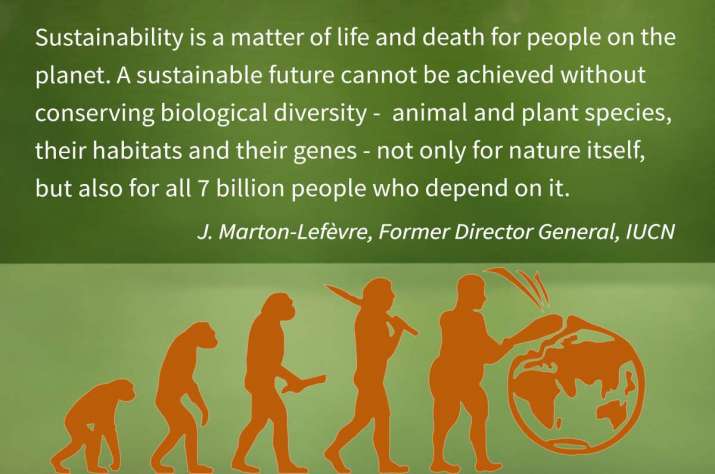
* THE IUCN RED LIST OF THREATENED SPECIES
** Analysis and valuation of the health and climate change cobenefits of dietary change (PNAS)
References
Fromm, Erich. 1973. The Anatomy of Human Destructiveness. New York: Holt, Rinehart & Winston.
Wilson, Edward O. 1984. Biophilia. Cambridge: Harvard University Press.
Buddhistdoor Special Issue 2017














